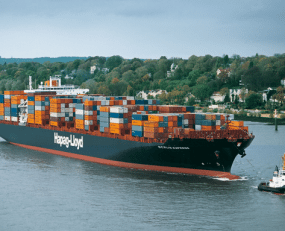
Klaus-Michael Kuehne, former CEO and Chairman of Kuehne and Nagel, has increased his investment in container shipping line Hapag-Lloyd AG. As the conglomerate TUI AG (which formerly owned Hapag-Lloyd) has sold down its shareholding, Mr Kuehne has increased his. Last week, TUI sold 8.5 million shares at €29.50, netting €244m. This final sell-off has resulted in an income of €406.7m for the company that now focuses on leisure. At the end of 2016, TUI held just over 12% of the equity of Hapag-Lloyd AG, now it holds nothing.
Although the success of Hapag-Lloyd as a strategic investment for TUI is questionable, since the merger with CSAV’s container line and UASC in 2016, the share price has doubled, moderating the pain of Hapag-Lloyd’s volatility over previous years. That said, when the Albert Ballin Consortium (of which Mr Kuehne was a prominent part) purchased a tranche of the pre-merger Hapag-Lloyd in 2011, it was estimated that TUI’s 38% stake was worth over €1bn.
Lloyd’s now reports that the Hamburg-based shipping line is now owned by a combination of the Saudi Arabian sovereign wealth fund (10%), CSAV (22.6%), Qatar Holdings (14.4%), the City of Hamburg (14.9%) and Kuehne Holdings (17.6%). The remaining fifth of the equity is freely floated on the German stock exchange.
The truth is that Hapag-Lloyd is a different company from the Hamburg-based shipping line that Klaus Michael Kuehne and the City of Hamburg bought into a decade ago. Consolidation in the container shipping market has resulted not only in different fleets and operational profiles but also a different base of investors. For Hapag-Lloyd, economies of scale remain an issue. Assuming the merger of COSCO and OOCL proceeds, the company will be the sixth-largest container line in the world just behind the Japanese ‘ONE’ combination. The prospect of further mergers and acquisitions appears likely. Yet with the Chinese spending at a furious rate, the long-term prospects for profits in the container shipping sector are far from assured.
Source: Transport Intelligence, July 18, 2017
Author: Thomas Cullen